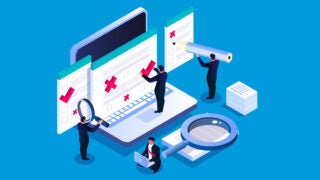USC professors examine the forces that influence voters
As citizens prepare to vote in the Nov. 3 election, complex forces are at work in shaping how people cast ballots. Some of the influences are obvious, like political advertising and presidential debates, but others are hidden in cybersecurity threats, digital fakes and the peculiar nature of the human mind. USC experts examine how hidden influences can shape an election outcome.
Contacts: Gary Polakovic (323) 527-7770 or polakovi@usc.edu; or USC media relations (213) 740-2215 or uscnews@usc.edu.
Efforts to undercut election integrity aim to squelch voters

Christina Bellantoni is a professor at the USC Annenberg School for Communication and Journalism and director of the Annenberg Media Center. A longtime political journalist, she is an expert in political reporting, social media and news industry change.
“Today, forces are at work to make people not participate in the election by questioning the integrity of elections and saying the system is broken,” Bellantoni said. “With so few people undecided about the upcoming presidential election, influencing just a handful of people on the margins can sway an election.”
She added:
- Fake news can sway voters. For example, the viral video on social media suggesting partisan postal workers could destroy ballots that indicate someone’s voter registration on the envelope.
- There were increased outbreaks of the Spanish Flu after people congregated at polling places in 1918, after a long period where people stayed home and in-person political events were banned.
- Many distrust the news media, in part because some journalists veer toward opinion on their social media channels more than ever before.
- Foreign agents, bots, social media echo chambers and White House attacks on the validity of elections can confuse voters.
Contact: christina.bellantoni@usc.edu
@cbellantoni
Blocs of the American electorate now live in fact-free zones

Norbert Schwarz is the Provost Professor of Psychology and Marketing at the USC Dornsife College of Letters, Arts and Sciences and the USC Marshall School of Business, as well as the co-director of USC Dornsife’s Mind and Society Center at USC. He is an expert in how the human mind makes decisions.
“We humans are terrible at discerning truth from untruth,” Schwarz said. “People are persuaded by messages that are simple, easy to process and agreeable. The more attention and effort it takes to process information, the more people look for ease in message assimilation. What’s easy to process becomes a proxy for truth. We are much more vulnerable to misinformation than we used to be.”
He added:
- The proliferation and fragmentation of media sources floods people with messages that can be difficult to sort.
- Gone are days when a few TV networks or newspapers provided a common narrative upon which to build American political consensus.
- People now shape their information diet to the exclusion of anything they don’t want to hear, sometimes resulting in fact-free realities.
- A democracy in which people can’t agree on facts, and people have alternative facts and realities, is not viable.
Contact: norbert.schwarz@usc.edu
@aanobs
Deepfakes are so good now that seeing is no longer believing

Wael AbdAlmageed is a professor at the USC Viterbi School of Engineering and the Information Sciences Institute. He’s an expert in multimedia forensics, machine learning and identifying deepfakes.
“Deepfakes have great power,” AbdAlmageed said. “They are a significant and growing risk to elections and democracy. There is now so much visual manipulation that the whole notion of ‘seeing is believing’ is not valid anymore. Deepfakes are dangerous and can sway an election or crash the stock market.”
He added:
- Worst-case scenario: A fraudulent video of a candidate goes viral on social networks just hours before polls close.
- Deepfakes are easy to make; a competent programmer could produce a persuasive fraud in 3 hours with a $2,000 computer.
- USC has developed state-of-the-art misinformation detection technology that can spot more than 96% of fraudulent videos in almost real time.
Contact: wamageed@isi.edu
@wamageed
Partisan orientation increasingly defines a person’s identity

John Matsusaka is the executive director of the Initiative and Referendum Institute at USC and a professor at the USC Marshall School of Business and the USC Gould School of Law.
“American identity politics has changed to where people don’t vote according to the identity of their church, union or job anymore,” Matsusaka said. “People decide how they vote by their partisan identity, which is often more important to them than the issues. We are becoming a tribal country, and tribal identities shape our votes today.”
He added:
- People have long voted according to partisan orientation, but what’s changed is partisanship has become a bigger part of people’s identity.
- The concept of American identity has changed; people see the opposing camp as the wrong kind of Americans.
- Democracy depends on political compromise, which is vanishing as the political center crumbles.
- The 2020 election will be unique and unpredictable because of large-scale mail-in balloting.
Contact: matsusak@usc.edu
@iriusc
U.S. elections are vulnerable to cybersecurity threats

Clifford Neuman is a scientist at the Information Sciences Institute and the Computer Science Department of the USC Viterbi School of Engineering. He is also the director of the USC Center for Computer Systems Security.
“Computers are used throughout the election process, and cyberattacks will target all aspects of this year’s election,” Neuman said. “Computers are used for voter registration, accepting political contributions, for get-out-the-vote activities, and practically all communication by campaigns. Journalists covering the election use computers to gather information and to publish their stories. Social media provides both a medium for the spread of information and misinformation, and it provides the information needed to target messaging to like-thinking segments of the citizenry.
“More directly, U.S. adversaries can manipulate elections by targeting the ballot recording and counting infrastructure. They can also target voters by email and phone, sending misleading information about polling places or mail-in deadlines. Cyberattacks can be mounted to create longer lines at polling locations, or to shut down locations in targeted communities. The threat is very concerning.”
He added:
- The United States is especially vulnerable to voter manipulation due to polarized politics and our protections regarding freedom of expression.
- Paper ballots are the best way to protect the integrity of the vote count.
- He is involved with the USC Cybersecurity Election Initiative — a series of workshops that raise awareness among election and campaign officials about cybersecurity threats.
Contact: bcn@isi.edu



